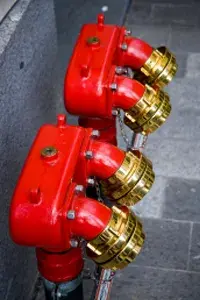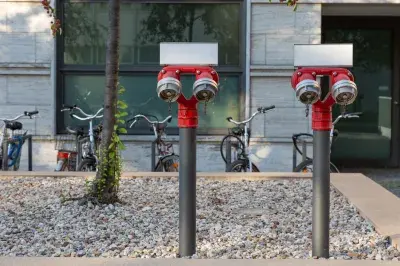A dry riser is used by the fire brigade to supply extinguishing water to the building. This device eliminates the need for the fire brigade to lay hoses, which can be time-consuming. Consequently, a much faster fire-fighting attack is possible. In case of fire, every minute counts!
In addition, a dry riser prevents the hose lines from being an obstacle in the escape routes. Accordingly, a dry extinguishing water system with a feed fitting, dry risers and tapping points also contributes to the fact that persons to be evacuated can use a safe escape route.
Dry riser: An overview

The type and design of the system with dry fire extinguishing lines is described in DIN 14462 (Extinguishing water facilities - Planning and installation of wall hydrant systems and extinguishing water lines). In addition, there may also be regional specifications.
Essentially, the system consists of a feed device, the location of which is coordinated with the fire protection service, as well as extraction devices at the required points in the building. This is supplemented by aerators and drains, which ensure safe operation during the filling phase and after use for draining the riser dry.
In case of fire, the fire brigade feeds water into the system, i.e. into the dry riser, via its emergency vehicle. The water is drawn off at the respective location.
When planning, a withdrawal at up to three points at the same time is taken into account. After use, the riser is drained dry by the emergency services, usually down to the level of the feeding device. Line sections below this level or those that cannot be reached dry due to the isometry of the riser must be equipped with automatic or hydraulic drains.
Note: Appropriate drainage systems must be considered. The same applies to aerators and deaerators, if applicable.

When is a dry extinguishing water pipe useful?

A system with dry extinguishing water pipes is required by building law where no self-help facilities (e.g. wall hydrants) are necessary for the layperson and the general conditions permit an operation. For example, a standard system can only be implemented up to a height of 30 m without an additional pressure boosting system, as fire brigades generally use pumps that can only guarantee sufficient pressure/volume flow at the highest tapping point up to this height.
Good to know: According to the standard, the supply and extraction points must be protected by cabinets and marked with pictograms.
The dry riser is an important component in plant fire protection. In principle, the intervention time can be significantly reduced with a dry extinguishing water pipe.
Inspection of the system - incl. riser dry
The system - including the dry riser - must be inspected every 2 years by an expert in accordance with DIN 14462. A shorter maintenance interval for the tapping point, dry riser and feed fitting is possible due to individual specifications. The recurring maintenance of the system with dry riser includes:
- Filling the extinguishing water pipes with water
- Testing for strength
- Checking the permissible pressure loss
- Inspection of the system structure
- Checking the functionality of the supply and discharge fittings as well as the aeration, venting and draining devices.
The test results of the system with dry riser must be documented in a test logbook and serve as proof for authorities and insurance companies.
Important: The responsibility for maintaining the system with dry risers, extraction point and feed fitting.


Advantages of the dry riser
- Fast extinguishing water supply in the building
- Reliable and high extinguishing performance in the building
- Laying of hose lines is not necessary, so escape routes remain accessible
Your expert for systems with dry risers
CWS Fire Safety takes over the planning, installation and testing of systems with dry risers - throughout Germany. The basis for this is DIN 14462 and, if applicable, regional specifications.
Find out more about our product and service portfolio in the field of extinguishing water technology!
Contact us for a non-binding consultation. Our experts are at your side for a standard-compliant implementation of the system with riser dry in your building.

